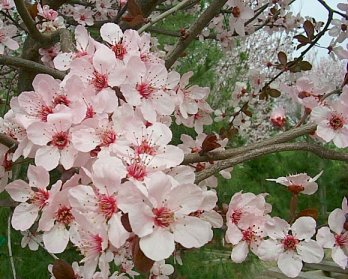| Botanical Name: Prunus cerasifera 'Krauter Vesuvius' | |
| Common Name: Krauter Vesuvius Purple-leaf Plum |

-
Anatomy
-
Culture
-
Design
Plant Type
Tree
Height Range
12-25'
Flower Color
Pink
Flower Season
Spring
Leaf Color
Purple, Red
Bark Color
Brown, Grey
Fruit Color
Red
Fruit Season
Summer
Sun
Full
Water
Medium
Growth Rate
Moderate
Soil Type
Sandy, Clay, Loam, Rocky, Unparticular
Soil Condition
Average, Rich, Poor, Well-drained, Dry
Soil pH
Neutral, Basic
Adverse Factors
Attracts Bees, Messy
Design Styles
English Cottage, Japanese
Accenting Features
Fragrance, Showy Flowers, Unusual Foliage
Seasonal Interest
Spring, Fall
Location Uses
Background, Perennial Border, Shrub Border, Foundation, Patio, Walls / Fences
Special Uses
Cut Flowers, Screen, Small Spaces
Attracts Wildlife
Birds
Information by: Stephanie Duer
Photographer: Seatree Nursery
Photographer: Seatree Nursery
-
Description
-
Notes
'Krauter Vesuvius' is a deciduous, small tree with a dense, twiggy, oval crown, growing to about 20 feet tall and 15 feet wide. It has light pink, fragrant flowers that emerge before the leaves. Leaves emerge a deep red and mature to a reddish purple; it retains this reddish color best in full sun. Small, red, edible fruit ripen July and August. Autumn leaf color is golden yellow to orange. Naturally low branching, and so place where that isn't an issue.
Grow in full sun in any well-drained soil; adaptive to a vartiety of soil types including clay, loamy-clay, and sandy-loam. pH adaptive. Prune after flowering (see Guides for tips).